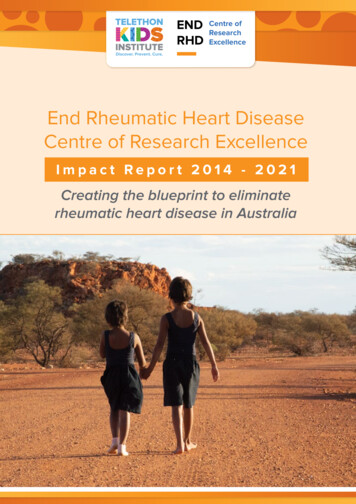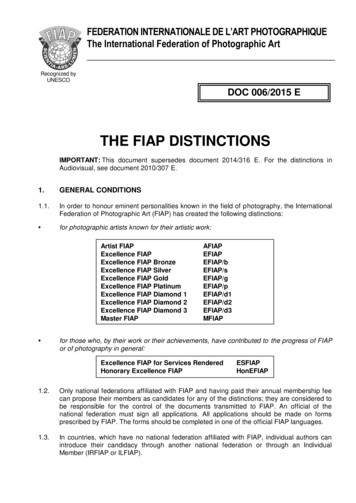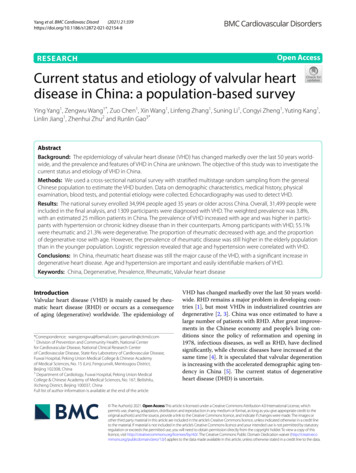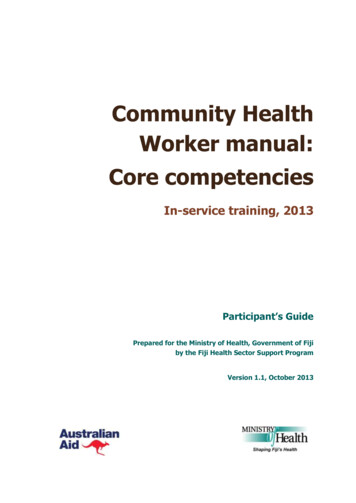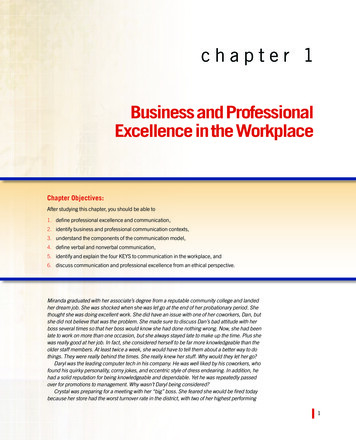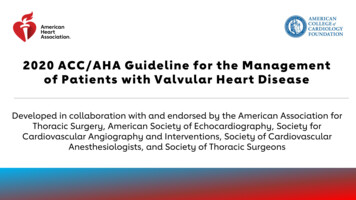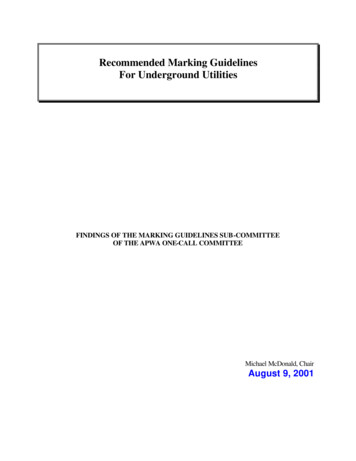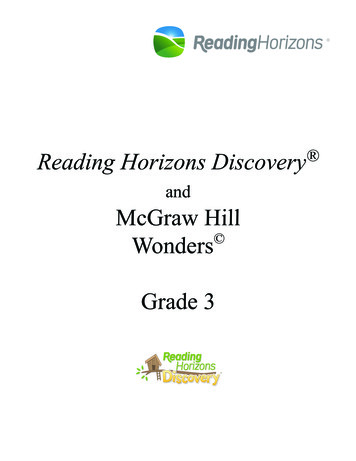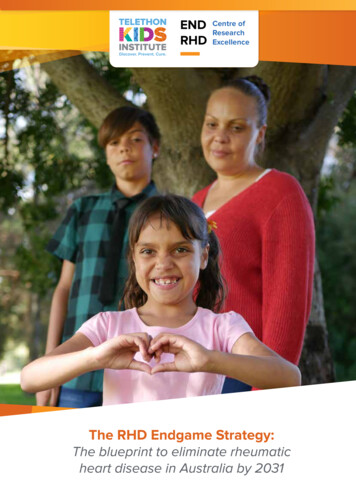
Transcription
ENDRHDCentre ofResearchExcellence
The Endgame Strategy is a product of collaboration between researchers, Aboriginal and Torres Strait Islanderleaders, communities and people with lived experience.The END RHD CRE investigators would like to thank the Aboriginal and Torres Strait Islander people who haveshared their stories in the Endgame Strategy. We acknowledge that the figures outlined represent the loss of humanlife with profound impact and sadness for people, families, community and culture.We thank all content experts who contributed their technical expertise, time and advice to the Endgame Strategy. Inparticular, we acknowledge the members of the END RHD Review Working Group, which comprised nominees fromEND RHD – the peak alliance leading work to eliminate RHD in Australia. Members of this working group providedinvaluable insight, reviewing content for feasibility and acceptability, and including review from a cultural perspective.Telethon Kids Institute acknowledges Aboriginal and Torres Strait Islander peoples as the Traditional Custodiansof the land and waters of Australia, and the lands on which this report was produced. We also acknowledge theNyoongar Wadjuk, Yawuru, Kariyarra and Kaurna Elders, their peoples and their land upon which the Institute islocated, and seek their wisdom in our work to improve the health and development of all children.Suggested citationWyber R, Noonan K, Halkon C, Enkel S, Ralph A, Bowen A, Cannon J, Haynes E, Mitchell A, Bessarab D,Katzenellenbogen J, Seth R, Bond-Smith D, Currie B, McAullay D, D’Antoine H, Steer A, de Klerk N, Krause V, SnellingT, Trust S, Slade R, Colquhoun S, Reid C, Brown A, Carapetis J. The RHD Endgame Strategy: The blueprint toeliminate rheumatic heart disease in Australia by 2031. Perth: The END RHD Centre of Research Excellence, TelethonKids Institute, 2020.end.rhd.cre@telethonkids.org.auThis document should be read in conjunction with Wyber R, et al. The RHD Endgame Strategy: A Snapshot. Theblueprint to eliminate rheumatic heart disease in Australia by 2031. Perth: The END RHD Centre of ResearchExcellence, Telethon Kids Institute, 2020 and Wyber R, et al. The Cost of Inaction on Rheumatic Heart Disease: Thepredicted human and financial costs of rheumatic heart disease for Aboriginal and Torres Strait Islander people 2016– 2031. Perth: The END RHD Centre of Research Excellence, Telethon Kids Institute, 2018. Variances in reportedfigures between each document reflect differences in modelling methods used, including the period of time underanalysis and inclusion of people who already have the disease in initial forecasts.This report was conducted with the support of the END RHD Centre of Research Excellence (END RHD CRE), which isfunded by a grant from the National Health and Medical Research Council (NHMRC). Grant Identification Number forthe Research Activity: 1080401. Data were collected and analysed through NHMRC Project Grant number 1146525– Burden of rheumatic heart disease (RHD) and impact of prevention strategies: comprehensive evidence to drivethe RHD Endgame Strategy. Alex Brown was supported by NHMRC Research Fellowship APP1137563. Anna Ralphis supported by an NHMRC Career Development Fellowship, #1142011. Andrew Steer was supported by the NHMRCand Heart Foundation of Australia. Rosemary Wyber is supported by NHMRC Postgraduate Scholarship APP1151165. 2020 Telethon Kids Institute. This work is protected by copyright. You may download, display, print, reproduce,and communicate this material in an unaltered form (retaining this notice) for your personal, non-commercial use ornon-commercial use within your organisation. The authors reserve all other rights in this work, including all rightsarising under the Copyright Act 1968 (Cth)
Contributors to the Endgame StrategyEND RHD CRE InvestigatorsJonathan Carapetis, Bart Currie, Graeme Maguire, Dawn Bessarab, Dan McAullay, Heather D’Antoine,Alex Brown, Karen Edmond (2015—17), Andrew Steer, Nick de Klerk, Vicki Krause, David Atkinson, GavinWheaton, Thomas Snelling, Anna Ralph (2017—), Rebecca Slade (2018—), Rosemary Wyber, SamanthaColquhoun, Christopher Reid and Claire Boardman (2015—18).END RHD Advisory CommitteeKate Armstrong, Jonathan Carapetis, Bart Currie, Karrina DeMasi, Catherine Halkon, John Havnen, DavidJohnson, Imran Mansoor, Anna Ralph, A. Merritt, Elizabeth Moore, Katharine Noonan, Vicki O’Donnell, JohnPaterson, Glenn Pearson, Angela Young, Rebecca Slade, Rebecca Smith, Simon Tatz, Patricia Turner, VickiWade and Neil Wilmett.Writing GroupAuthors for each section of the Endgame Strategy are outlined below. Content responsibility for the fulldocument rests with the END RHD CRE Investigators.Chapter 1 Burden of Strep A, ARF and RHDJudith Katzenellenbogen, Jeffrey Cannon, Rebecca Seth, Daniela Bond-Smith, Rosemary Wyber,Katharine Noonan and Stephanie EnkelChapter 2 The lived experience of ARF and RHDEmma Haynes, Alice Mitchell, Stephanie Enkel, Rosemary Wyber and Dawn Bessarab.John Woods is acknowledged for his assistance with developing the terms for the database searches. KateHarford is acknowledged for writing the family stories shared in the Endgame.Chapter 3 The policy contextCatherine Halkon and Stephanie EnkelChapter 4 Strategies to end RHDRosemary Wyber, Katharine Noonan, Asha Bowen, Anna Ralph, Stephanie Enkel and Catherine HalkonChapter 5 Health and economic impactJeffrey Cannon, Rosemary Wyber and Katharine NoonanReview GroupThe CRE would like to particularly acknowledge the END RHD Review Working Group, comprisingnominees for the Founding Member Organisations, who reviewed content for feasibility and acceptability,inclusive of review from a cultural perspective.Kate Armstrong, Lorraine Anderson, Michaela Coleborne, Karrina DeMasi, John Havnen, Imran Masoor, A.Merritt, Elizabeth Moore, Vicki Wade and Angela Young.The END RHD CRE Investigators are grateful for the technical expertise, time and advice of the followingreviewers who contributed to various sections of the Endgame Strategy.Ross Bailie, Julie Bennett, Hilary Bloomfield, Pasqualina Coffey, Ellen Donnan, Michelle Dowden, MarkEngel, Josh Francis, Nick Georges, Caterina Giorgi, Kate Hardie, Emma Haynes, Adam Heaton, DavidHendrickx, Ari Horton, Anna-Louise Kimpton, Matthew Lester, James Marangou, Elizabeth McDonald,Malcolm McDonald, Tracy McRae, Nirrumbuk EH&S, Sara Noonan, Simon Quilty, Benjamin Reeves,Boglarka Reményi, Kathryn Roberts, Rosalie Schultz, Nicola Slavin, Mike Stephens, Melissa Stoneham, PaulTorzillo and Geraldine Vaughan.Technical supportJessica de Dassel, Charlize Donovan, Elizabeth Eadie-Mirams, Kate Harford, Tamara Hunter and StephaniePegler.Endorsing OrganisationsEndorsing Organisations
Contents PageFOREWORD. 10EXECUTIVE SUMMARY. 11Strategies to eliminate RHD. 11Priority Action Areas. 14INTRODUCTION TO THE ENDGAME STRATEGY. 17Overview of Strep A, ARF and RHD. 19Structure and methods of the RHD Endgame Strategy. 20CHAPTER 1 BURDEN OF STREP A, ARF AND RHD. 25Strep A Infections. 26Acute Rheumatic Fever. 29Rheumatic Heart Disease. 33CHAPTER 2 THE LIVED EXPERIENCE OF ARF AND RHD. 43Finding answers for Tenaya: from a sore throat to open-heart surgery. 44A ray of sunshine for other kids living with RHD: Billi Joh's story Introduction. 45Methods. 46Results. 47Discussion. 56Conclusion. 57Diagnosed at four, Chad is learning to live with RHD. 58CHAPTER 3 THE POLICY CONTEXT. 59Introduction. 60RHD prevention in Australia. 61Health system and policies. 65Health system monitoring and reporting. 67Critical enabling policies. 68Reform and guiding principles. 70CHAPTER 4 STRATEGIES TO END RHD. 75Introduction. 76CHAPTER 4A STRUCTURAL AND SYSTEM CONSIDERATIONS IN ADDRESSING STREP A. 79INFECTIONS, ARF AND RHDIntroduction. 80Approach, structure and scope.81NATSIHP Focus Area: Aboriginal and Torres Strait Islander Health workforce. 83NATSIHP Focus Area: Aboriginal and Torres Strait Islander organisations. 86NATSIHP Focus Area: Cultural wellbeing. 93NATSIHP Focus Area: Cross-Sector partnerships. 95NATSIHP Focus Area: Strong families and communities. 96NATSIHP Focus Area: Healthy Living. 97Synthesis of structural and system recommendations in addressing Strep A infections, . 97ARF and RHDCHAPTER 4B ADDRESSING ENVIRONMENTAL, SOCIAL AND ECONOMIC DETERMINANTS. 99OF STREP A INFECTIONIntroduction. 100Healthy Living Practice 1 – Washing people. 104Healthy Living Practice 2 – Washing clothes and bedding. 115Healthy Living Practice 3 – Removing wastewater safely. 124Healthy Living Practice 4 – Improving nutrition, the ability to store, prepare and cook food. 125Healthy Living Practice 5 – Reducing the negative impacts of overcrowding. 126Healthy Living Practice 6 – Reducing the negative effects of animals, insects and vermin. 135Healthy Living Practice 7 – Reducing the health impacts of dust. 140Healthy Living Practice 8 – Controlling the temperature of the living environment. 140Healthy Living Practice 9 – Reducing minor trauma. 141Summary of strategies to increase Healthy Living Practices. 143Synthesis of environmental and social determinant of health recommendations. 145CHAPTER 4C PRIMARY PREVENTION OF ACUTE RHEUMATIC FEVER. 147Introduction. 148Pre-primary Prevention. 150PrimaryPrevention.154Post-primary Prevention. 201Summary of strategies to improve primary prevention of ARF and RHD. 204Synthesis of primary prevention recommendations. 207CHAPTER 4D SECONDARY PREVENTION OF ARF AND RHD. 211Introduction. 212Secondary prevention. 215Summary of strategies to improve secondary prophylaxis. 247Synthesis of secondary prevention recommendations. 249CHAPTER 4E TERTIARY CARE FOR PEOPLE WITH RHD. 251Introduction. 252Tertiary care. 254Summary of strategies to improve tertiary care. 279Synthesis of tertiary care recommendations. 281CHAPTER 5 – HEALTH AND ECONOMIC IMPACT. 283Introduction. 284Results. 288Case for investment. 292Conclusion. 293Priority Action Areas. 294APPENDICES. 297Appendix One: Data sources. 298Appendix Two: Consolidated Indigenous Regions used for the ERASE dataset. 299Appendix Three: Population estimates of Indigenous young people. 300Appendix Four: Transmission mechanisms for Strep A infections, scabies and crusted scabies. 301Appendix Five: School exclusion guidelines. 302Appendix Six: Measuring the impact of the Endgame Strategy. 303Appendix Seven: Modelling methods. 309Appendix Eight: Cost of prevention strategies. 313Appendix Nine: Defining the population at risk of ARF and RHD. 316REFERENCES. 319
GlossaryEndorsing OrganisationsABSAustralian Bureau of StatisticsHPAHealth Policy AnalysisACCHOAboriginal Community Controlled Health OrganisationICOPIndigenous Cardiac Outreach ProgramACCHSAboriginal Community Controlled Health ServiceITCIntegrated Team CareACSQHCAustralian Commission on Safety and Quality in Health CareIAHPIndigenous Australians' Health ProgrammeACTAustralian Capital TerritoryIHDIschaemic heart diseaseACWAboriginal Community WorkerIREGIndigenous RegionsAFAtrial fibrillationMBSMedicare Benefits ScheduleAHPAboriginal Health PractitionerMDAMass drug administrationAHMACAustralian Health Ministers’ Advisory CouncilNACCHONational Aboriginal Community Controlled Health OrganisationAHWAboriginal Health WorkerNATSIHPNational Aboriginal and Torres Strait Islander Health PlanAIGAboriginal Investment GroupNSQHSNational Safety and Quality Health ServiceAIHWAustralian Institute of Health and WelfareNATSIHWANational Aboriginal and Torres Strait Islander Health Worker AssociationAMAAustralian Medical AssociationNHMRCNational Health and Medical Research CouncilAMSAboriginal Medical ServiceNTAHFNorthern Territory Aboriginal Health ForumAMSANTAboriginal Medical Services Alliance Northern TerritoryNPANational Partnership (or Project) AgreementAPSGNAcute post-streptococcal glomerulonephritisNSWNew South WalesAPY LandsAnangu Pitjantjatjara Yankunytjatjara LandsNTNorthern TerritoryARFAcute rheumatic feverPCISPatient care information systemASRAge-standardised ratePBSPharmaceutical Benefits SchemeASRRAge-standardised rate ratioPCRPolymerase chain reactionATSICAboriginal and Torres Strait Islander CommissionPHCPrimary healthcareATSIHPAboriginal and Torres Strait Islander Health PractitionerPoCTPoint-of-care testingBenzathine benzylpenicillinQAAMSQuality Assurance for Aboriginal and Torres Strait Islander Medical ServicesAlso referred to as LAB, BLA, Bicillin L-A, Bicillin, BPB, Benzathine penicillin GQLDQueenslandRACGPRoyal Australian College of General PractitionersRADTRapid antigen detection testRAAHSRemote Area Aboriginal Health ServicesBPGCABGCoronary artery bypass graftCentral Australian Rural Practitioners Association Standard Treatment ManualsCARPA STMA collection of protocols for the management of common conditions seen in remote (mainlyAboriginal and Torres Strait Islander) health practiceCDNACommunicable Diseases Network AustraliaRNRegistered nurseCHCCOAG Health CouncilRFSRheumatic Fever StrategyCHCIChild Health Check InitiativeCHDCongenital heart disease or childhood heart diseaseRFS CommunitiesCommunities receiving RFS funding and support to prevent and manage ARF and RHDannounced in October 2018CHWCommunity Health WorkerCOAGCouncil of Australian GovernmentsRHDRheumatic heart diseaseCKDChronic kidney diseaseRHDARheumatic Heart Disease AustraliaCNOSCanadian National Occupancy StandardSASouth AustraliaCOPDChronic obstructive pulmonary diseaseSDOHSocial determinants of healthCQIContinuous quality improvementSoNGSeries of National GuidelinesCSANZCardiac Society of Australia and New ZealandSPSecondary prophylaxisCTGClosing the GapTASTasmaniaEND RHD CREEnd Rheumatic Heart Disease Centre of Research ExcellenceVICVictoriaERASE ProjectEnd RHD in Australia: Study of Epidemiology ProjectWAWestern AustraliaGPGeneral practitioner or general practiceWHAWorld Health AssemblyHLPHealthy Living PracticeWHOWorld Health OrganizationWoFWarrant of FitnessGlossaryRheumatic Fever Strategy Communities
ForewordTo many Australians, rheumatic heart disease (RHD)is a foreign concept – a disease most will havenever heard of. But for my people, RHD continuesto pose a very real and present threat. Despitehaving been eliminated in the non-IndigenousAustralian population for decades, RHD continuesto devastate Aboriginal and Torres Strait Islandercommunities at some of the highest rates in theworld. Starting with a simple Strep A infectionof the throat or skin, RHD can be fatal withouttreatment. There is no cure and children whohave the disease must endure a painful penicillininjection every 21–28 days for at least five yearsor until they are 21, whichever comes first. Many,some as young as five years old, must also haveopen heart surgery. For these children and theirfamilies – who must be taken off country to largetertiary hospitals for months at a time – it is oftenthe emotional scars that last the longest.In 2016 Professor Jonathan Carapetis came tome in my capacity as the newly appointed CEOof the National Aboriginal Community ControlledHealth Organisation (NACCHO) to discuss formingEND RHD – an alliance between the AboriginalCommunity Controlled Health Sector and healthand research bodies, all committed to ending RHD.As he outlined the plan, it became clear that wehad an unprecedented opportunity to end thisdevastating disease.Professor Carapetis and colleagues had beenfunded by the National Health & Medical ResearchCouncil to develop an RHD Endgame Strategy: ablueprint outlining exactly what needed to happen– and who needed to do it – to eliminate RHDfor the next generation of Aboriginal and TorresStrait Islander children. But what set this researchtranslation piece apart from previous work wasthat it was to be created with Aboriginal and TorresStrait Islander people, rather than for us: it was tobe a research-driven strategy that had at its corethe voices of those living with and impacted by RHD.This was significant, because our people alreadyknow what needs to happen to eliminate RHD.Communities have long told us they needsupport to tackle the problems which contributeto the spread of Strep A infection: things likeovercrowding and a lack of access to infrastructuresuch as hot water and running showers – basicamenities most Australians take for granted.Aboriginal Health Workers in communities withthe highest RHD burden have told us they needsupport and resources to grow the workforce andcatch more sore throats and skin sores before10Executive SummaryRheumatic heart disease (RHD) is preventable. The collective experience of communities, clinicians,Aboriginal Community Controlled Health Organisations, government and non-government organisations,in addition to over 25 years of research, means the knowledge and evidence base now exists toeliminate rheumatic heart disease in Australia.The Endgame Strategy brings together this experience, knowledge and evidence for the first time,presenting an opportunity for Australia to implement a comprehensive, long-term strategy to end RHD.they lead to acute rheumatic fever (ARF), theprecursor to RHD. Most importantly, people livingwith ARF and RHD have told us they need bettertreatments and culturally safe care so they can livetheir lives to the fullest. The Endgame Strategyhonours and reflects all these views, adding themto the evidence base that will underpin the workneeded to eliminate RHD – work that will further‘close the gap’ by helping to eliminate linkeddiseases like otitis media, trachoma and kidneydisease.In my work leading the Coalition of the Peaks– a historic partnership between the Council ofAustralian Governments (COAG) and Aboriginaland Torres Strait Islander leaders – we arecommitted to addressing the structural andsystemic changes that have led to the gap inoutcomes, including life expectancy, betweenIndigenous and non-Indigenous Australians. TheEndgame Strategy recommendations echo thisnew framework and, when implemented, will go along way to closing this gap.The Endgame Strategy heralds a new chapterwhere ending RHD is genuinely possible. We havethe Aboriginal leadership, community demand, andevidence base to support the work that can makethis disease history. All we’re missing is the fundingto make this a reality. If the CommonwealthGovernment is to meet its pledge to eliminate RHDin this decade, Australian governments must actupon this report. The Endgame Strategy cannotbe consigned to a bookshelf to sit, gatheringdust. The actions – or inaction – of today will befelt by the next generation of our people, and forgenerations after that. It is unconscionable to letthem suffer as a result of RHD when we now havean Endgame to prevent it.RHD disproportionately affects Aboriginal and Torres Strait Islander people. Currently, around 420Aboriginal and Torres Strait Islander people have a diagnosed episode of acute rheumatic fever (ARF)each year,1 a rate 123 times higher than rates in non-Indigenous people. Of the more than 5,000 peopleliving with RHD in Australia, 71% are Aboriginal and Torres Strait Islander people.1 This represents one ofthe highest per capita burdens of RHD in the world.Without action, it is estimated that a further 8,667 Aboriginal and Torres Strait Islander people willdevelop ARF or RHD by 2031. Of these people, 1,370 will have severe RHD and 663 will die, with 273.4million required to be spent on medical care.2 Aboriginal and Torres Strait Islander children are most atrisk of developing the disease.Ending RHD will not just eliminate the disease for the next generation of Aboriginal and Torres StraitIslander children – it will help to close the gap caused by other diseases of inequity.Eliminating RHD means preventing new cases of disease. The Endgame Strategy outlines the bestexisting evidence-based strategies to prevent new cases of RHD in Australia, in line with the biomedicalmodel of disease: Structural and system considerations: Central to any disease-specific strategy is a wellresourced, culturally secure primary healthcaresystem. Local partnerships to support communitiesalso require links to housing, education, meaningfulemployment and environmental health services. Environmental, social and economic determinants:Action must be taken to address theenvironmental and socio-economic causes ofStrep A infections leading to ARF and RHD, withinvestment in collaborative, community-led solutions. Primary prevention: Strategies which improvethe assessment and treatment of skin and throatinfections will prevent ARF in people at high risk ofthe disease. Secondary prevention: In order to preventprogression of ARF to RHD, strategies are needed toimprove the early and accu
blueprint to eliminate rheumatic heart disease in Australia by 2031. Perth: The END RHD Centre of Research Excellence, Telethon Kids Institute, 2020 and Wyber R, et al. The Cost of Inaction on Rheumatic Heart Disease: The predicted human and financial costs of rheumatic heart disease for Aboriginal and Torres Strait Islander people 2016 - 2031.
